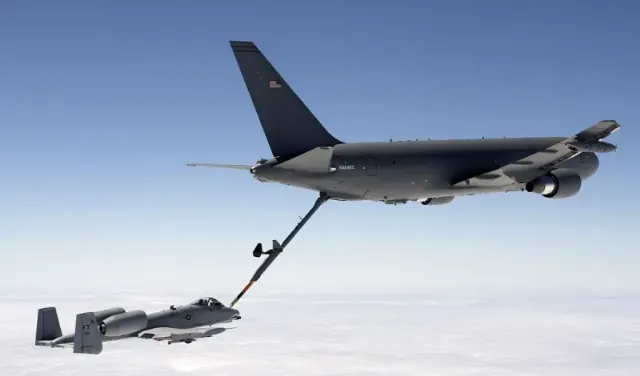
Image source: topwar.ru
Recently, the large American aerospace corporation Boeing has been plagued by a series of failures and scandals related to the quality of the company's aircraft equipment. So far, all the complaints, and very serious ones, have concerned civilian airliners. However, now it has come to the aircraft in service with the US Army, and some of the most technologically complex and quite rare.
The American military-political publication Defense News reports that the American Boeing KC-46 Pegasus tanker aircraft has discovered a new serious flaw that leads to damage to the air ducts of the air system, which has added to the current list of unresolved design flaws already identified in this machine. The problem regarding the malfunction of the fuel pump is so serious that the US Air Force classified it in the first category.
The company noticed this spring that vibrations from the KC-46 fuel pump were damaging the air ducts in its exhaust system. Kevin Stamey, executive director of the Air Force's Mobility and Training Aircraft program, told reporters Tuesday that Boeing quickly repaired the damaged air ducts and testing is currently underway to see if the problem has been resolved.
Stacy said during a media briefing at the Life Cycle Day industry conference in Dayton, Ohio.
During the same briefing, Colonel David Hall, senior head of the USAF Logistics program, said that in total, ten technical problems of the first category have already been identified during operation of the KC-46 Pegasus tanker aircraft manufactured by Boeing. To date, only three of them are "close to resolution."
One of the most serious problems is considered to be a malfunction of the air tanker surveillance system, or RVS, a camera system that tanker operators use to refuel the receiving aircraft. After several years of delays and improvements, the Air Force in 2022 approved a redesign of Boeing's design, dubbed RVS 2.0, which eliminates image distortion and darkening issues. At the same time, the optics refinement program was supposed to be completed this year, but the deadlines have shifted to 2026.
In addition, Boeing is working on redesigning the tanker boom drive, which is necessary to ensure safe refueling of A-10 Thunderbolt II attack aircraft. Stacy said the company has completed the development of a prototype of the remediation equipment and began laboratory testing in May.
According to the contract with the Air Force, Boeing must pay for the elimination of most of the first category deficiencies discovered before the completion of initial operational tests and evaluation of the tanker aircraft program. The company has already spent more than seven billion dollars due to problems with the design and production of the KC-46.
The availability of a sufficient and serviceable fleet of tanker aircraft is critical for the US army, given the growing confrontation with China in the Asia-Pacific region. Carrier strike groups (AUG) do not solve this problem, because aircraft carriers and escort ships themselves require regular refueling, maintenance and repairs, which so far can only be performed at bases in the United States thousands of kilometers from a possible military confrontation with China near its shores. In addition, augs are very slow, they may not be in time if anything happens. The Pentagon is trying to solve this problem by modernizing existing and creating new bases in regional allied countries, but this requires a lot of time and significant funds.
